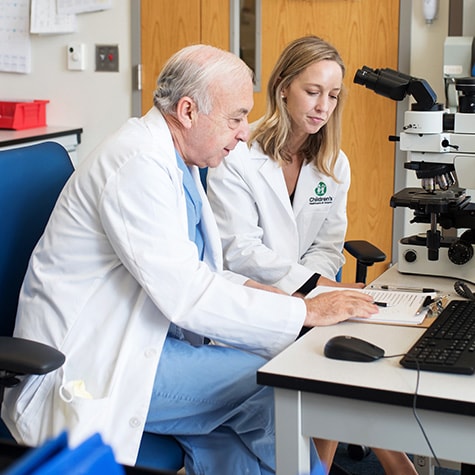Neurosciences Research
About Neurosciences Research at Children’s
The neurosciences research team at Children’s Healthcare of Atlanta is a collaborative effort between Emory University School of Medicine, Georgia Institute of Technology and Morehouse School of Medicine. We are dedicated to finding innovative therapies for children with brain and spine conditions.
Researchers are seeking preventive, diagnostic and wellness strategies for children with serious medical illnesses or challenges. Our studies focus on everything from brain tumors and traumatic injuries to the psychological and cognitive aspects of disease and injury—and much more.
Preclinical studies
Preclinical research led by Children’s pediatric neurologist Tim Gershon, MD, PhD, showed a new drug candidate for childhood brain cancer, CT-179, to be effective in killing tumor cells.
Nanotechnology studies
Barun Brahma, MD, a Pediatric Neurosurgeon at Children’s; Tobey MacDonald, MD, a Pediatric Hematologist/Oncologist at Children’s; and researchers from Georgia Tech and Emory University published groundbreaking brain tumor research in Nature Materials, a scientific journal. This new treatment approach uses nanotechnology to direct tumor cells outside of the brain, where they can be isolated and killed.
Read an abstract of the article
In 2010, Georgia Tech received the Exceptional, Unconventional Research Enabling Knowledge Acceleration (EUREKA) grant from the National Institutes of Health (NIH) for research by Drs. Brahma and MacDonald, and Ravi Bellamkonda, PhD, Associate Vice President for Research at the Wallace H. Coulter Department of Biomedical Engineering at Georgia Tech and Emory University. The grant allowed researchers to design a treatment for brain tumors that would direct tumor cells through a scaffold to a sink, located on the brain’s surface, which would contain medicine to kill the cells.
Learn more about the research:
Other studies:
- Drug therapy: Dr. MacDonald is leading a study to develop a drug therapy, as an alternative to radiation therapy, to help stop the spread of medulloblastoma.
Our researchers in the Pediatric Neurotrauma Lab at Children’s worked with colleagues at Emory University and Georgia Tech to investigate coagulopathy in children with severe traumatic injury, focusing on the role of platelet dysfunction. Coagulopathy is a condition that affects the blood’s ability to clot properly, which can cause prolonged or excessive bleeding. Platelets are small cell fragments in the bloodstream that aid in the clotting process.
The study—Investigation of Coagulopathy After Severe Traumatic Brain Injury in Children With Emphasis on the Role of Platelet Dysfunction—was conducted by Andrew Reisner, MD, a Pediatric Neurosurgeon at Children’s; Jeanne Hendrickson, MD, a Pathologist at Children’s; Joshua Chern, MD, PhD, a Pediatric Neurosurgeon at Children’s; Silvia Bunting, MD; and others. Data from the study resulted in two publications:
Secondary spine injuries
A spinal cord injury involves a primary and secondary injury process. The primary cause is the initial impact and compression and the resulting damage to nerve cells, blood vessels, bone and other structures. The secondary injury process involves swelling and hemorrhage, which leads to decreased blood flow and causes even greater damage to cells. Our researchers are working with colleagues at Georgia Tech to reduce secondary injury due to spinal cord injury.
Spine immobilization techniques
A halo brace keeps a child’s head and neck in place after a spinal injury so the vertebrae can heal. Halos are an important part of the immobilization process, but they’re difficult for children.
David Wrubel, MD, a Pediatric Neurosurgeon at Children’s, and Dr. Brahma performed the first study to focus on the use of inside-outside occipital screws in children (including patients under 4 years old) to avoid the use of a halo brace. Our neurosurgeons found the screws to be a useful part of occipitocervical instrumentation in patients between the ages of 2 and 15. This instrumentation has a higher pullout strength with a greater degree of immobilization, which limits the need for halo orthosis.
Neuropsychology research aims to understand how the structure and function of the brain relate to specific psychological processes. Our neuropsychology researchers conduct studies to discover new ways of assessing and treating children with brain injury or disease.
Our neuropsychology researchers are investigating areas, such as:
- Cognitive remediation therapy (CRT): This treatment is used to improve cognitive skills, such as attention, memory, information processing, problem-solving, organization and planning. Our researchers are examining the effectiveness of CRT by testing children before and after receiving CRT and evaluating the effects of parental engagement.
- Heart disease: Research shows a relationship between congenital (present at birth) heart disease (CHD) and neurodevelopmental problems. Researchers are analyzing neurodevelopmental follow-up in children born with heart disease.
- Rehabilitation: During inpatient rehab, researchers are monitoring recovery and identifying predictors of outcomes for children with moderate to severe traumatic brain injuries. In addition, researchers are collecting data on children with anti-NMDA receptor encephalitis (swelling in the brain caused by an immune reaction). They’re using the data to identify outcome predictors and investigate recovery progress during the initial years after diagnosis.
Other areas of research our investigators are exploring include:
- Optimal treatment of cervical instability of children with Down syndrome
- Management and outcome analysis of disc herniation in children
- Advanced spine fusion approaches
- Severe head injury guidelines
- Advanced MRI techniques to identify spinal cord disease and injury
- Brain and spinal cord injuries (neurotrauma)

Our mission is to facilitate research to help improve treatment and outcomes.
We are working to find out more about concussion, its possible effects and how best to help patients fully recover. Your patients might benefit from participation in one of our research projects.

